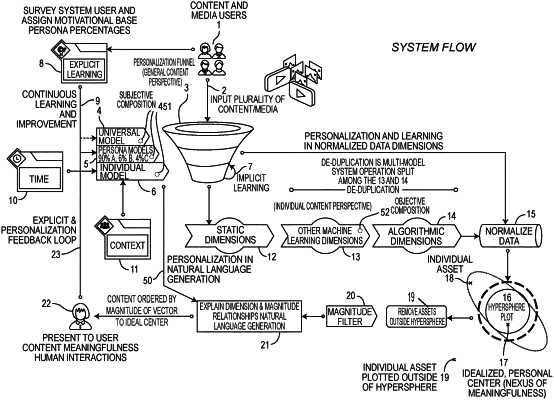| CPC G06Q 30/0201 (2013.01) [G06F 40/40 (2020.01); G06N 5/045 (2013.01); G06N 20/00 (2019.01)] | 20 Claims |

|
1. A computer-implemented method for photo selection, executed by a hardware processor of a computer, said computer-implemented method comprising the steps of:
having a user upload a group of photos from a computer device into a non-transitory computer-readable storage medium of the computer;
having the computer store the group of photos in the non-transitory computer-readable storage medium;
having the computer administer an explicit learning user survey to the user via a graphical user interface displayed on the computer device to obtain survey results;
having the hardware processor of the computer perform an initial pixel analysis of the group of photos that have been uploaded and stored in the non-transitory computer-readable storage medium;
having the hardware processor allocate an assigned persona to the user based on the initial pixel analysis of the group of photos that have been uploaded and the survey results;
having the hardware processor use the assigned persona to serve as a baseline behavioral and preference model and having the hardware processor use the baseline behavioral and preference model to adjust predictions for content selection;
having the hardware processor utilize a machine learning algorithm run by the hardware processor to create and train an initial individual model for the user, wherein the initial individual model comprises a user-specific predictive model tailored to understand subjective tendencies influenced by broad motivational biases, said initial individual model being developed through pixel-level analysis of the group of photos that have been uploaded, targeting identification of both human-readable and machine-readable behaviors, biases, and preferences encapsulated in images during a photo capture process;
using said initial individual model in combination with a photo evaluation persona and a universal photo understanding model to select a set of photos from the group of photos that were uploaded, thereby providing a photo selection;
employing the graphical user interface on the computer device to present the photo selection to the user;
having the hardware processor generate natural language feedback via a natural language processing algorithm, said natural language feedback explaining a rationale behind the photo selection to the user;
employing the graphical user interface on the computer device to display the photo selection and the natural language feedback;
having the computer receive user feedback via the graphical user interface;
having the hardware processor modify the initial individual model to create a modified individual model based on the received user feedback and further implicit learning from photo analysis, using the machine learning algorithm;
having the hardware processor re-select the set of photos for one of two purposes: (1) refining the photo selection based on the modified individual model, or (2) selecting an alternative set from a new group of uploaded photos, both influenced by the modified individual model, wherein the modified individual model has an impact on both data generated by the machine learning algorithm and final selection criteria employed by the machine learning algorithm;
displaying the re-selected set of photos to the user via the computer device;
having the hardware processor monitor new content uploaded into the non-transitory computer-readable storage medium; and
having the hardware processor reassess and adjust the modified individual model and the assigned persona based on the new content and further implicit learning from the photo analysis, using the machine learning algorithm.
|